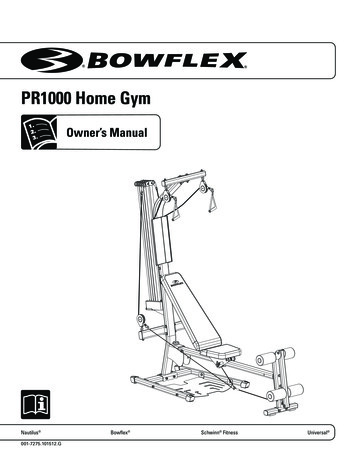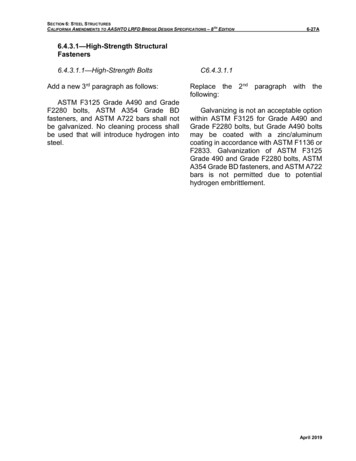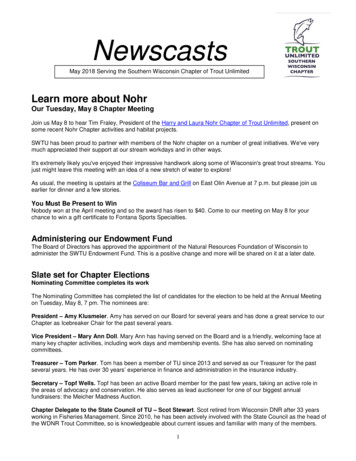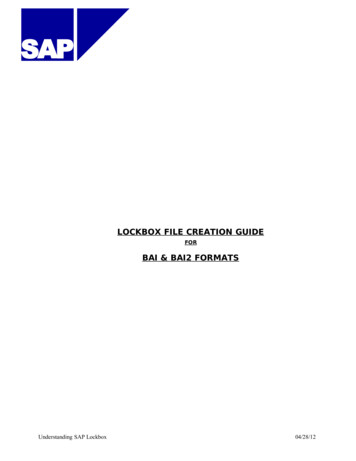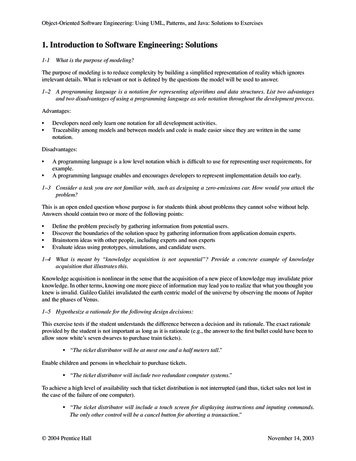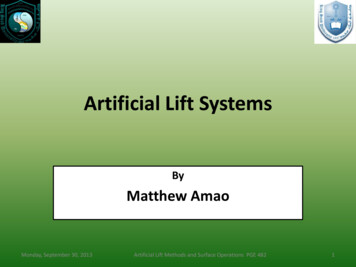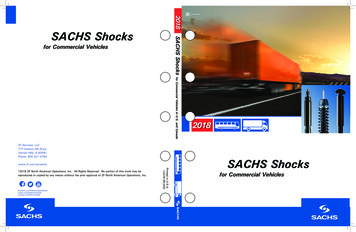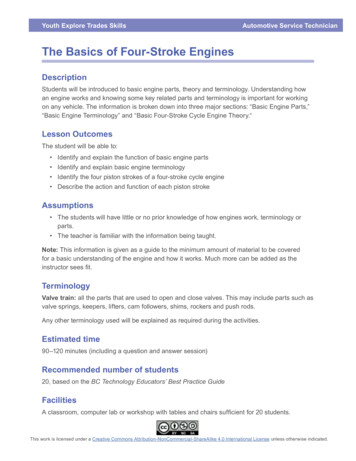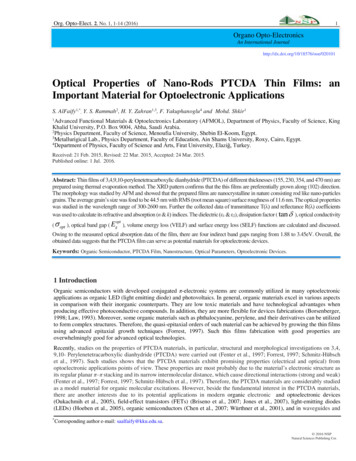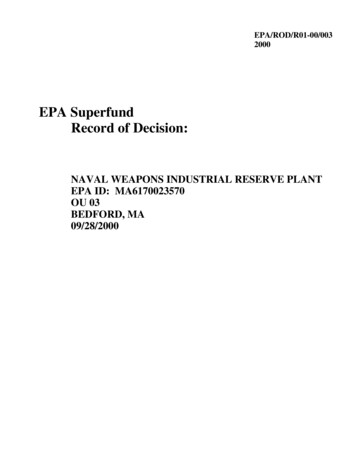
Transcription
EPA/ROD/R01-00/0032000EPA SuperfundRecord of Decision:NAVAL WEAPONS INDUSTRIAL RESERVE PLANTEPA ID: MA6170023570OU 03BEDFORD, MA09/28/2000
RECORD OF DECISIONSITE 2 - COMPONENTS LABORATORY FUEL OIL TANKNAVAL WEAPONS INDUSTRIAL RESERVE PLANTBEDFORD, MASSACHUSETTSSEPTEMBER, 2000
Record of DecisionNaval Weapons Industrial Reserve Plant BedfordTable of ContentsPART 1: THE DECLARATIONSITE NAME AND LOCATION . . . . . . . . . . . . . . . . . . . . . . . . . . . . . . . . . . . . . . . . . . . . . . . . . . . . . . . 1STATEMENT OF BASIS AND PURPOSE . . . . . . . . . . . . . . . . . . . . . . . . . . . . . . . . . . . . . . . . . . . . . 1DESCRIPTION OF SELECTED REMEDY . . . . . . . . . . . . . . . . . . . . . . . . . . . . . . . . . . . . . . . . . . . . 1STATUTORY DETERMINATIONS . . . . . . . . . . . . . . . . . . . . . . . . . . . . . . . . . . . . . . . . . . . . . . . . . . . . 2AUTHORIZING SIGNATURES . . . . . . . . . . . . . . . . . . . . . . . . . . . . . . . . . . . . . . . . . . . . . . . . . . . . . . . 2PART 2: THE DECISION SUMMARY1.SITE NAME, LOCATION AND DESCRIPTION . . . . . . . . . . . . . . . . . . . . . . . . . . . . . . . . . . . 32.SITE HISTORY AND ENFORCEMENT ACTIVITIES . . . . . . . . . . . . . . . . . . . . . . . . . . . . . . . 3Site History . . . . . . . . . . . . . . . . . . . . . . . . . . . . . . . . . . . . . . . . . . . . . . . . . . . . . . . . . . . . . . . . . 3History of Investigations . . . . . . . . . . . . . . . . . . . . . . . . . . . . . . . . . . . . . . . . . . . . . . . . . . . . . . . 4History of CERCLA Enforcement Activities . . . . . . . . . . . . . . . . . . . . . . . . . . . . . . . . . . . . . . 53.COMMUNITY PARTICIPATION . . . . . . . . . . . . . . . . . . . . . . . . . . . . . . . . . . . . . . . . . . . . . . . . 54.SCOPE AND ROLE OF RESPONSE ACTION . . . . . . . . . . . . . . . . . . . . . . . . . . . . . . . . . . . 65.SITE CHARACTERISTICS . . . . . . . . . . . . . . . . . . . . . . . . . . . . . . . . . . . . . . . . . . . . . . . . . . . . 66.CURRENT AND POTENTIAL FUTURE SITE AND RESOURCE USES . . . . . . . . . . . . . . 87.SUMMARY OF SITE RISKS . . . . . . . . . . . . . . . . . . . . . . . . . . . . . . . . . . . . . . . . . . . . . . . . . . . 88.DOCUMENTATION OF NO SIGNIFICANT CHANGES . . . . . . . . . . . . . . . . . . . . . . . . . . . 119.STATE ROLE . . . . . . . . . . . . . . . . . . . . . . . . . . . . . . . . . . . . . . . . . . . . . . . . . . . . . . . . . . . . . . 11PART 3: THE RESPONSIVENESS SUMMARY1.STAKEHOLDER ISSUES AND EPA RESPONSES . . . . . . . . . . . . . . . . . . . . . . . . . . . . . 142.TECHNICAL AND LEGAL ISSUES . . . . . . . . . . . . . . . . . . . . . . . . . . . . . . . . . . . . . . . . . . . 14APPENDICESAppendix A:Appendix B:Appendix C:Appendix D:Appendix E:Massachusetts DEP Letter of Concurrence . . . . . . . . . . . . . . . . . . . . . . . . . . . . . . . . . . . . .References . . . . . . . . . . . . . . . . . . . . . . . . . . . . . . . . . . . . . . . . . . . . . . . . . . . . . . . . . . . .Glossary of Terms and Acronyms . . . . . . . . . . . . . . . . . . . . . . . . . . . . . . . . . . . . . . . . . . . .Administrative Record Index and Guidance Documents . . . . . . . . . . . . . . . . . . . . . . . . . . . . .E1. Transcript of Public Hearing . . . . . . . . . . . . . . . . . . . . . . . . . . . . . . . . . . . . . . . . . . . . .E2. Copy of Public Comment . . . . . . . . . . . . . . . . . . . . . . . . . . . . . . . . . . . . . . . . . . . . . . .151719202734
Record of DecisionNaval Weapons Industrial Reserve Plant BedfordPart 1: The DeclarationPART 1: DECLARATION FOR THE RECORD OF DECISION1.0 Site Name and LocationNaval Weapons Industrial Reserve Plant (NWIRP) BedfordHartwell RoadBedford, Massachusetts 01730MA6170023570Site 2, Operable Unit 2 - Components Laboratory Fuel Oil Tank2.0 Statement of Basis and PurposeThis decision document presents the No Further Action decision for Site 2, Operable Unit 2, the ComponentsLaboratory Fuel Oil Tanks (Site 2) at NWIRP Bedford, which was chosen in accordance with the ComprehensiveEnvironmental Response, Compensation and Liability Act of 1980 (CERCLA), 42 USC § 9601 et seg., as amendedby the Superfund Amendments and Reauthorization Act of 1986 (SARA), and, to the extent practicable, theNational Oil and Hazardous Substances Pollution Contingency Plan (NCP), 40 CFR Part 300 et seq., as amended.This decision was based on the Administrative Record, which has been developed in accordance with Section 113(k) of CERCLA, and which is available for review at the Navy’s Northern Division In Lester Pennsylvania and at theUnited States Environmental Protection Agency (EPA) Region 1 OSRR Records Center in Boston, Massachusetts.A public information repository is also kept at the Bedford Public Library In Bedford, Massachusetts. TheAdministrative Record Index (Appendix D to the ROD) identifies each of the items comprising the AdministrativeRecord upon which the selection of the remedial action is based.The Massachusetts Department of Environmental Protection (DEP) and EPA Region 1 concur with the SelectedRemedy.3.0 Description of the Selected RemedyThis ROD sets forth the No Further Action decision for Site 2. There are no principal or low-level threats at Site 2.No further action is necessary at Site 2 to protect human health and the environment.Site 2, Operable Unit 2 is one of 4 operable units at this site. The four operable units were defined based on theirspecific site problems and the actions performed to address the problems over time. Site 2, was defined based on arelease to soils in a limited geographical portion of NWIRP Bedford. Site 2 has been addressed independently fromthe rest of NWIRP Bedford so that the Navy can proceed with closure of this site as soon as it has met therequirements of the Superfund process. Since No Further Action is proposed for Site 2, the Record of Decision(ROD) for this site can be completed this year. The proposed No Further Action for Site 2 is not expected to haveany impact on the strategy or progress for the rest of the sites at NWIRP Bedford. Additional details on the strategyand schedule for the remediation for NWIRP Bedford can be found in the Site Management Plan (2000).Record of DecisionSite 2, OU2 NWIRP BedfordBedford, MassachusettsVersion: FinalDate: September, 2000Page 1 of 35
Record of DecisionNaval Weapons Industrial Reserve Plant BedfordPart 1: The Declaration4.0 STATUTORY DETERMINATIONSNo Further Action is required to ensure protection of human health and the environment.Because this No Further Action decision will not result in hazardous substances remaining on-site above levels thatallow for unlimited use and unrestricted exposure, a five-year review will not be required for this remedial action.5.0 AUTHORIZING SIGNATURESThis ROD documents that No Further Action is necessary to ensure protection of human health and the environmentfor Site 2, Operable Unit 2 at NWIRP Bedford. This remedy was selected by the Navy and EPA with concurrence ofthe Massachusetts Department of Environmental Protection.Concur and recommended for immediate implementation:Record of DecisionSite 2, OU2 NWIRP BedfordBedford, MassachusettsVersion: FinalDate: September, 2000Page 2 of 35
Record of DecisionNaval Weapons Industrial Reserve Plant BedfordPart 2: The Decision SummaryPART 2: THE DECISION SUMMARY1.0 SITE NAME, LOCATION, AND DESCRIPTIONThe Naval Weapons Industrial Reserve Plant (NWIRP) Bedford is located in the town of Bedford in MiddlesexCounty, Massachusetts (Figure 1). NWIRP was placed on the National Priorities List (NPL) in May 1994 by theUnited States Environmental Protection Agency (EPA) pursuant to the Comprehensive Environmental Response,Compensation, and Liability Act (CERCLA) of 1980. There are several sites within the NWIRP NPL Site that theNavy is addressing under CERCLA. This Record of Decision (ROD) relates to Site 2, Operable Unit 2, ComponentsLaboratory Fuel Tank (Site 2) which is located near the northeastern edge of NWIRP, Bedford (Figure 2).The NWIRP property consists of an approximately 46-acre parcel that is owned by the Navy and currently operatedby Raytheon Company. The northern portion of NWIRP Bedford is located on Hartwells Hill, at an approximate peakelevation of 205 feet above mean sea level (msl). The northern slope of Hartwells Hill drops steeply on the Navyproperty to an elevation of approximately 140 feet msl at the northernmost property boundary. The central andsouthern portions of NWIRP Bedford are located on the gentler southern slopes of Hartwells Hill, at an elevation ofapproximately 130 feet.NWIRP Bedford is located near the headwaters of the Shawsheen River. A tributary of the Shawsheen River, ElmBrook, flows near the northern and western boundaries of NWIRP Bedford. Elm Brook flows at the base of HartwellsHill, approximately 400 feet from the Navy property at its closest passing. Elm Brook flows in a northerly tonortheasterly direction to its confluence with the Shawsheen River, approximately 1.2 miles northeast of NWIRPBedford.The mission of NWIRP Bedford is to design, fabricate, and test prototype weapons equipment, such as missileguidance and control systems. Activities at NWIRP Bedford are conducted in two main structures: theComponents Laboratory and the Flight Test Facility. Other main structures on the facility include the AntennaRange Building, Facility Storage Building, and Transportation Buildings. A significant portion of the site is paved.Land use adjacent to NWIRP Bedford is zoned residential, though sparsely populated. NWIRP Bedford adjoins theRaytheon Company facilities, Hanscom Air Force Base (to the south), Massachusetts Institute of Technology’sinstrumentation laboratory hangar and test laboratory (to the west), and the Air Force’s Cambridge Research Center(to the south). There is a trailer park associated with the Hanscom Air Force Base that lies between the north andsouth sides of NWIRP Bedford. The nearest residence, with the exception of the trailers, is about 600 feet to thenortheast.A more complete description of Site 2 can be found in Sections 1 and 3 of the RI Phase II Report (TetraTech NUS,2000).2.0 SITE HISTORY AND ENFORCEMENT ACTIONSSite HistoryConstruction of NWIRP Bedford began in 1952 when a missile and radar development laboratory, later called theComponents Laboratory, was built. The laboratory's mission was to provide Raytheon with facilities for research anddevelopment of radar, missile guidance systems, and related equipment. Flight test facilities were added to the southernportion of the site in 1959. Between 1959 and 1977, the Navy obtained a total of 43.12 additional acres from the AirForce.Record of DecisionSite 2, OU2 NWIRP BedfordBedford, MassachusettsVersion: FinalDate: September, 2000Page 3 of 35
Record of DecisionNaval Weapons Industrial Reserve Plant BedfordPart 2: The Decision SummaryBuildings constructed during the past 25 years include a large facility storage and other government buildings near thenorthern end of the property, an Antenna Range Building between them, air conditioning and incineration facilities, andthe Advanced Medium Range Air to Air Missile Development (AMRAD) Building.NWIRP Bedford's mission is to design, fabricate, and test prototype equipment for missile guidance and controlsystems. The advanced technology research and development takes place in two main buildings, the ComponentsLaboratory and the Flight Test Facilities. In the Components Laboratory, hardware prototypes are fabricated, assembledfrom components, and run through vibration, drop, and non-destructive testing. There are also areas in the building foroffice space and other activities. The Flight Test Facility supports flight testing of product models and consists of ahangar, an aircraft maintenance area, and office space.Site 2 is one of four sites at NWIRP Bedford. The ROD for Site 2 has been addressed independently from the rest ofNWIRP Bedford so that the Navy can proceed with closure of this site as soon as it has met the requirements of theSuperfund process. Since No Further Action is proposed for Site 2, it is expected that a ROD for this site can becompleted this year. The proposed No Further Action for Site 2 is not expected to have an impact on the strategy orprogress for the rest of the sites at NWIRP Bedford. Additional details on the strategy and schedule for the remediationof NWIRP Bedford can be found in the Site Management Plan (2000).The Initial Assessment Study (IAS) indicated that several hundred gallons of number 6 fuel oil had leaked from theunderground storage tank at Site 2 in 1983. The underground storage tank and contaminated soil were excavated andremoved from the site. Site 2 was considered to be a potential source of contamination due to the presence of petroleumrelated constituents in soil at the site. Groundwater in this area has not been impacted by the soil contamination.Soil, soil vapor, and groundwater samples were collected in the vicinity of the Components Laboratory Fuel Tank toidentify the source(s) of contamination and delineate the extent of contamination related to Site 2. Section 4.5 of theRI Phase II provides a description of the data collected to identify the source(s) and extent of contamination at Site 2.History of InvestigationsPrevious investigations and the enforcement activities of Site 2 are summarized below: Installation Restoration Program (IRP), 1975. In response to the growing awareness of the potential effects ofhazardous materials on human health and the environment, the Department of Defense (DOD) developed the IRPto investigate and cleanup potential problem areas created by past events at federal facilities. The IRP was thecatalyst for environmental investigations at the NWIRP. Initial Assessment Study (IAS), Rogers, Golden, and Halpern, 1986. The purpose of the IAS was to identify andevaluate past hazardous waste practices at the NWIRP and make an assessment of the associated potential forenvironmental contamination. The IAS identified Site 2 and identified fuel compounds as potential chemicals ofconcern (COCs). Phase I Remedial Investigation Study (RI) NWIRP, Dames and Moore, 1989. Site 2 was identified as one of severalNWIRP sites posing potential risks to human health and the environment. The Phase I RI determined that totalpetroleum hydrocarbons (TPH) were present in soil, but that petroleum related constituents are not present in Site2 groundwater.Record of DecisionSite 2, OU2 NWIRP BedfordBedford, MassachusettsVersion: FinalDate: September, 2000Page 4 of 35
Record of DecisionNaval Weapons Industrial Reserve Plant BedfordPart 2: The Decision Summary Supplemental Investigation, Dames and Moore, 1990. This was a limited site investigation to identify potentialcontaminant source areas. It included a facility inspection, analytical results of groundwater monitoring, and gassurvey. TPH levels in soil vapor samples from Site 2 were generally low. An estimation of the quantities of various solvents, fuels, and oils potentially released into the environment in variouslocations at the facility in addition to Site 2 was used to score NWIRP Bedford under the CERCLA Hazard RankingSystem and resulted in the placement of NWIRP Bedford on the EPA's NPL in May 1994. Draft RI Phase II, Brown and Root Environmental, January 1994. Work performed during the Phase II RI addressedand filled data gaps from the Phase I RI and previous investigations in order to further delineate the degree andextent of contamination. Draft Final RI Phase II, TetraTech NUS, 1996 and 1997. Additional data gaps from the Draft Phase II RI were filledto identify potential sources of contamination. A baseline human health and ecological risk assessment wasperformed that indicated that threats to health and environment exist. Low levels of TPH were identified in soils atSite 2. Site 2 was characterized as a release to surface soils only. Previously identified chlorinated solvents wereattributed to Site 3. Final RI Phase II completed, TetraTech NUS, 2000. Supplemental investigations of Sites 3, 4, and the SouthernFlight Test Area were performed to evaluate potential sources and extent of contamination at these sites. Theupdated risk assessment, evaluating a residential receptor at Site 2, found no unacceptable risk to human healthor the environment for Site 2.A more detailed description of the Site history can be found in Section 1.3 of the RI Phase II Report.History of CERCLA Enforcement ActivitiesNWIRP Bedford was placed on EPA's NPL in 1994. Environmental cleanup activities at the Site have continued inaccordance with CERCLA since that time. The Federal Facility Agreement (FFA) became effective in February 2000.The FFA established enforceable schedules and deadlines for cleanup activities. In accordance with the FFA, a SiteManagement Plan (SMP) with task schedules and deliverables is updated annually each October.3.0 COMMUNITY PARTICIPATIONThroughout the Site’s history, community concern and involvement has been moderate. The Navy has kept thecommunity and other interested parties apprised of Site activities through informational meetings, fact sheets, pressreleases, public meetings and regular contact with local officials. Also, the Navy meets on a regular basis to discussthe status and progress of the IRP with the Restoration Advisory Board (RAB), which includes representatives from theneighboring community. Representatives from the Navy, EPA Region 1, DEP, and local government have attended allpublic meetings and hearings.In September 1995, the Navy initiated a series of public meetings, at which the RAB process was explained andcommunity members were asked to join the RAB. A sufficient number of volunteers were assembled and RAB meetingsbegan to be held in March 1996. Since that time, RAB meetings have been held as needed to keep the RAB and localcommunity informed of IRP activities, which has been approximately on a quarterly basis. These meetings have providedupdates of RI and FS activitiesRecord of DecisionSite 2, OU2 NWIRP BedfordBedford, MassachusettsVersion: FinalDate: September, 2000Page 5 of 35
Record of DecisionNaval Weapons Industrial Reserve Plant BedfordPart 2: The Decision Summarythroughout the process. The Site Management Plan (SMP), which serves as a management tool for planning, reviewing,and setting priorities for environmental investigative and remedial response activities to be conducted at NWIRP Bedford,was completed in 1999, and is updated annually. The SMP is available for review at the Navy's Northern Division inLester, Pennsylvania and at the Bedford Public Library in Bedford, Massachusetts. On July 5, 2000 the Navy made the administrative record available for public review at the Navy's Northern Divisionin Lester, Pennsylvania. An information repository has also been made available to the public at the Bedford PublicLibrary in Bedford, Massachusetts. This will be the primary information repository for local residents and will bemaintained by the Navy. On July 13, 2000, the Navy published a notice and brief analysis of the Proposed Plan in the Bedford and LexingtonMinuteman newspaper and made the plan available to the public at the Bedford Public Library. From July 5, 2000 to August 8, 2000, the Navy held a 30 day public comment period to accept public comment onthe Proposed Plan. On July 19, 2000, the Navy held an informational meeting to present the Navy's Proposed Plan to a broadercommunity audience than those that had already been involved at the Site. At this meeting, representatives fromthe Navy answered questions from the public. On July 19, 2000, the Navy held a public hearing to discuss the Proposed Plan and to accept any oral comments.A transcript of this meeting and the comments and the Agency's response to comments are included in theResponsiveness Summary, which is part of this Record of Decision.4.0 SCOPE AND ROLE OF RESPONSE ACTIONSite 2 is one of four CERCLA sites within the NWIRP NPL Site. There are no principal or low-level threats at Site 2. NoFurther Action is necessary at Site 2 to protect human health and the environment.Site 2 is defined by a release to soil only. No release to other media (air, groundwater) was identified at Site 2. Site 1is also a release to soil only. Sites 3 and 4 of the NWIRP NPL Site include releases to groundwater as well as soil.The ROD for Site 2 has been addressed independently from the rest of NWIRP Bedford so that the Navy can proceedwith closure of this site as soon as it has met the requirements of the Superfund process. Since No Further Action isproposed for Site 2, it is expected that a ROD for this site can be completed this year. The proposed No Further Actionfor Site 2 is not expected to have an impact on the strategy or progress for the rest of the sites at NWIRP Bedford.Additional details on the strategy and schedule for the remediation of NWIRP Bedford can be found in the SiteManagement Plan (2000).5.0 SUMMARY OF SITE CHARACTERISTICSSite 2 is located at the northeastern corner of the Components Laboratory near the northeastern edge of the NWIRPfacility (Figure 2). The Initial Assessment Study (IAS) indicated that several hundred gallons of number 6 fuel oil hadleaked from the tank in 1983. The underground storage tank and contaminated soil were excavated and removed fromthe site. Site 2 was considered to be a potential source of contamination due to the presence of petroleum relatedconstituents in soil at the site. Groundwater inRecord of DecisionSite 2, OU2 NWIRP BedfordBedford, MassachusettsVersion: FinalDate: September, 2000Page 6 of 35
Record of DecisionNaval Weapons Industrial Reserve Plant BedfordPart 2: The Decision Summarythis area has not been impacted by the soil contamination.Soil, soil vapor, and groundwater samples were collected in the vicinity of the Components Laboratory Fuel Tank toidentify the source(s) of contamination and delineate the extent of contamination related to Site 2. Section 4.5 of theRI Phase II provides a description of the data collected to identify the source(s) and extent of contamination at Site 2.The significant findings of the Rl are summarized below. One source area, the former underground storage tank, was identified at Site 2. The underground storage tank andcontaminated soils were removed from the site. Low concentrations of total petroleum hydrocarbons (TPH) have been identified in shallow soils at this site. Thereleases were identified as releases to surface soil only. No migration pathways to groundwater were identified.Previously identified chlorinated solvents in area groundwater were attributed to Site 3.Record of DecisionSite 2, OU2 NWIRP BedfordBedford, MassachusettsVersion: FinalDate: September, 2000Page 7 of 35
Record of DecisionNaval Weapons Industrial Reserve Plant BedfordPart 2: The Decision Summary Based on the conceptual site model for Site 2 and the fact that identified contaminant concentrations in soil arelow enough that it could be possible that remediation and/or access restrictions to the site would not be necessary,a human health and ecological risk assessment was conducted. The results of the risk assessment are presentedbelow in the Summary of Site Risks.6.0 CURRENT AND POTENTIAL FUTURE SITE AND RESOURCE USESThe current site use is industrial, and is fenced and partially guarded to control access. The current adjacent andsurrounding land uses are both industrial and residential in nature. The area to the northwest and north containswoodlands and wetland areas that are undeveloped. Residential areas are located to the west and southwest (temporarytrailer housing for Hanscom field workers) and to the east (private residences). Industrial areas are located to the south(Hanscom Field) and to the west (Raytheon Missile Systems Division facilities). The reasonably foreseeable future useof the Site and surrounding land is expected to be similar to the current use pattern, i.e., a mix of industrial andresidential use. However, for the purposes of site evaluation, the Navy has assumed that there will be unrestricted useof Site 2, and that future site use could be residential with no controlled access. The groundwater underlying Site 2 isbeing addressed separately by the cleanup process for other operable units and sites at NWIRP Bedford.7.0 SUMMARY OF SITE RISKSAs part of the Draft RI Phase II (1997), the Navy performed a baseline risk assessment at Site 2 to estimate theprobability and magnitude of potential adverse human health and environmental effects from exposure to contaminantsassociated with Site 2 assuming no remedial action was taken. The human health risk assessment followed a four-stepprocess: 1) hazard identification, which identified those hazardous substances that, given the specifies of the site, wereof significant concern; 2) exposure assessment, which identified actual or potential exposure pathways, characterizedthe potentially exposed populations and determined the extent of possible exposure; 3) toxicity assessment, whichconsidered the types and magnitude of adverse health effects associated with exposure to hazardous substances; and4) risk characterization and uncertainty analysis, which integrated the three earlier steps to summarize the potentialand actual risks posed by hazardous substances at the site, including carcinogenic and non-carcinogenic risks anda discussion of the uncertainty in the risk estimates.In the Draft RI Phase II baseline risk assessment, potential human health effects associated with exposure to thechemicals of potential concern were estimated through the development of two hypothetical receptors: on-site workersand occasional trespassing teenagers. These receptors were developed to reflect the potential for exposure tohazardous substances assuming the future industrial use of the site.Record of DecisionSite 2, OU2 NWIRP BedfordBedford, MassachusettsVersion: FinalDate: September, 2000Page 8 of 35
Record of DecisionNaval Weapons Industrial Reserve Plant BedfordPart 2: The Decision SummaryExcess lifetime cancer risks were determined for each receptor by multiplying a daily intake level with thechemical-specific cancer potency factor. Cancer potency factor's have been developed by EPA from epidemiologicalor animal studies to reflect a conservative “upper bound” of the risk posed by potentially carcinogenic compounds. Theresulting risk estimates are expressed in scientific notation as a probability (e.g., 1 x 10-6 for 1/1,000,000) and indicatethat an average individual is not likely to have greater that a one in a million chance of developing cancer over 70 yearsas a result of site-related exposure to the compound at the stated concentration. All risks estimated represent an"excess lifetime cancer risk," or the additional cancer risk on top of that which we all face from other causes. EPA'sgenerally acceptable risk range for site-related exposure is 10-4 to 10-6. There are no carcinogenic risks in excess ofthis generally acceptable lifetime risk range at Site 2.In assessing the potential for adverse effects other than cancer, a hazard quotient (HQ) is calculated by dividing the dailyintake level by the reference dose (RfD) or other suitable benchmark. RfDs have been developed by EPA and representa level to which an individual may be exposed that is not expected to result in any deleterious effect. RfDs are derivedfrom epidemiological or animal studies and incorporate uncertainty factors to help ensure that adverse health effectswill not occur. A HQ # 1 indicates that a receptor's dose of a single contaminant is less than the RfD, and that toxicnoncarcinogenic effects from that chemical are unlikely. The Hazard Index (HI) is generated by adding the HQs for allchemical(s) of concern that affect the same target organ (e.g. liver) within or across those media to which the sameindividual may reasonably be exposed. A HI # 1 indicates that toxic noncarcinogenic effects are unlikely. The baselinerisk assessment performed as part of the Draft RI Phase II non-potential cancer risks at Site 2 did not exceed the EPAHI value of 1.The baseline risk assessment also evaluated areas of concern for potential ecological risk, based on a step-wisescreening procedure. Areas that lacked ecological receptors were excluded from further evaluation. The area surroundingSite 2 is predominantly industrial, with significant impervious (paved) surface area. No significant ecological habitatreceptors are present. Based on the lack of environmental receptors, no unacceptable ecological risks are expectedat Site 2.The Navy then performed a more conservative risk analysis for the Final RI Phase II report (TetraTech NUS 2000) toevaluate whether site conditions were protective of human health with a potential future residential land use or whetherinstitutional controls were required. The findings of this assessment are described below.The evaluated risk scenario assumed that a residential receptor, initially as a child and later as an adult, could beexposed to site soil through incidental ingestion of and dermal contact with soil. The results of the risk characterizationindicated that based on conservative exposure scenarios developed to account for future residential use of Site 2,predicted risks to human health as a result of potential exposure to surface soil are within the EPA target cancer riskrange and below the target hazard index. When predicted cancer risk levels are less than the lower end of the cancerrisk range (1 x 10-6), the general risk management decision is that no further action needs to be taken at the site. Onthe other hand when predicted cancer risk levels are greater than the upper end of the cancer risk range (1 x 10-4), thisgenerally indicates the need for further action at the site. When cancer risk levels are within the range (as was the caseat this site),
EPA/ROD/R01-00/003 2000 EPA Superfund Record of Decision: NAVAL WEAPONS INDUSTRIAL RESERVE PLANT EPA ID: MA6170023570 OU 03 BEDFORD, MA 09/28/2000
